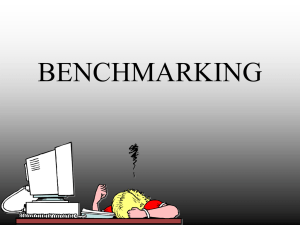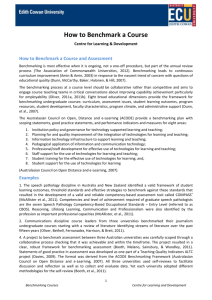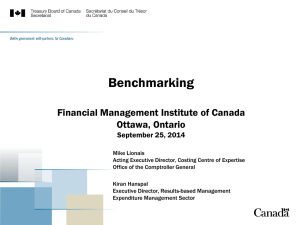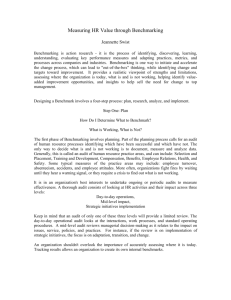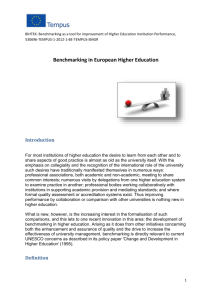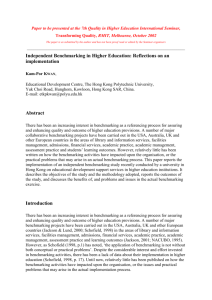BIHTEK: Benchmarking as a tool for improvement of Higher
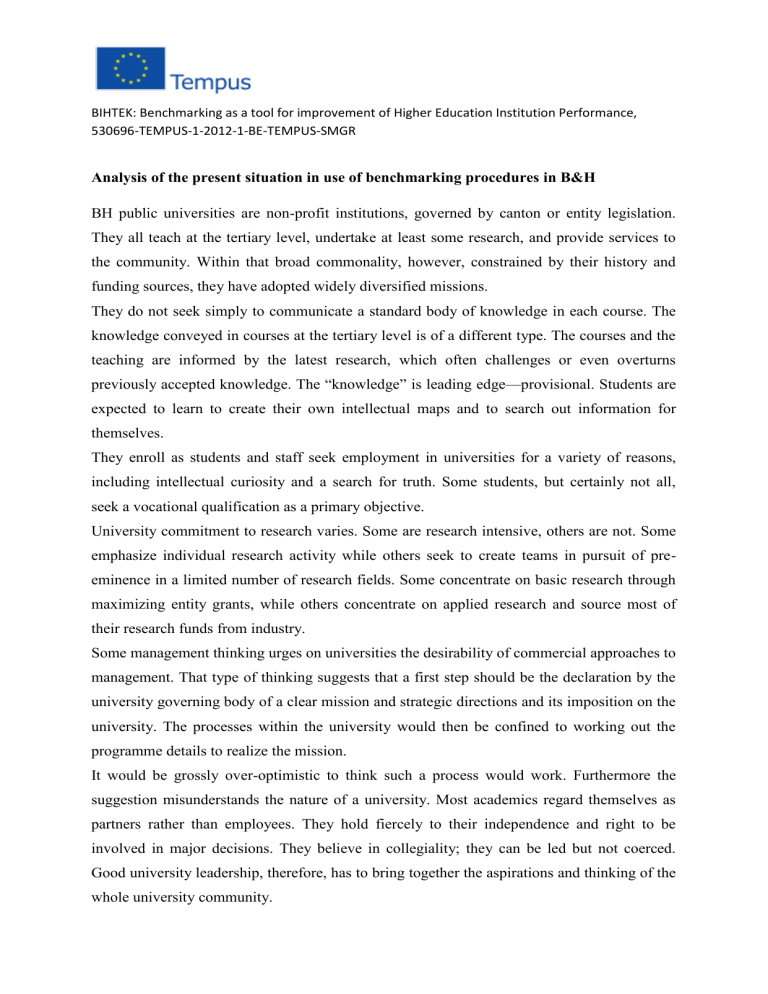
BIHTEK: Benchmarking as a tool for improvement of Higher Education Institution Performance,
530696-TEMPUS-1-2012-1-BE-TEMPUS-SMGR
Analysis of the present situation in use of benchmarking procedures in B&H
BH public universities are non-profit institutions, governed by canton or entity legislation.
They all teach at the tertiary level, undertake at least some research, and provide services to the community. Within that broad commonality, however, constrained by their history and funding sources, they have adopted widely diversified missions.
They do not seek simply to communicate a standard body of knowledge in each course. The knowledge conveyed in courses at the tertiary level is of a different type. The courses and the teaching are informed by the latest research, which often challenges or even overturns previously accepted knowledge. The “knowledge” is leading edge—provisional. Students are expected to learn to create their own intellectual maps and to search out information for themselves.
They enroll as students and staff seek employment in universities for a variety of reasons, including intellectual curiosity and a search for truth. Some students, but certainly not all, seek a vocational qualification as a primary objective.
University commitment to research varies. Some are research intensive, others are not. Some emphasize individual research activity while others seek to create teams in pursuit of preeminence in a limited number of research fields. Some concentrate on basic research through maximizing entity grants, while others concentrate on applied research and source most of their research funds from industry.
Some management thinking urges on universities the desirability of commercial approaches to management. That type of thinking suggests that a first step should be the declaration by the university governing body of a clear mission and strategic directions and its imposition on the university. The processes within the university would then be confined to working out the programme details to realize the mission.
It would be grossly over-optimistic to think such a process would work. Furthermore the suggestion misunderstands the nature of a university. Most academics regard themselves as partners rather than employees. They hold fiercely to their independence and right to be involved in major decisions. They believe in collegiality; they can be led but not coerced.
Good university leadership, therefore, has to bring together the aspirations and thinking of the whole university community.
BIHTEK: Benchmarking as a tool for improvement of Higher Education Institution Performance,
530696-TEMPUS-1-2012-1-BE-TEMPUS-SMGR
It is in the nature of the request for new knowledge that no external authority can say with certainty that the approaches chosen by particular individuals or a particular university are irrefutably wrong.
In most aspects universities are thus to be measured by criteria other than profit or return on assets.
Universities have not been at all keen on the university league tables which try to show comparisons and which are invidious and unfair.
2. Quality assurance in BH HEI as the basis for development of benchmarking methodology
Higher education institutions in B&H have progressively implemented more systematic, formalized quality assurance processes, recognizing this as a way to achieve greater efficiency and accountability within their organization.
The development of university quality assurance processes has occurred in concert with the governments’ establishment of quality models and organizations designed to audit and review university performance across state and national boundaries. Institutional and national quality models and performance indicators are considered vital components in raising the standard of higher education.
The rationale behind performance models and indicators in higher education is to ensure the education providing students to be prepared for employment and providing the nation with a highly skilled workforce that supports economic growth.
Higher education institutions and national level governments use performance indicators for different purposes.
Higher education institutions use performance indicators for three primary reasons:
1. To facilitate the assessment and evaluation of institutional operations
2. To provide information for external quality assurance audits, and
3. To provide information to the government for accountability and reporting purposes
BIHTEK: Benchmarking as a tool for improvement of Higher Education Institution Performance,
530696-TEMPUS-1-2012-1-BE-TEMPUS-SMGR
Due to these differences in purpose at national and institutional levels, there will necessarily be diverse perspectives on appropriate performance indicator and measure use and type.
BH higher education institutions use performance indicators to monitor their own performance, to facilitate the assessment of institutional operations, and to provide evidence for typically external quality assurance audits of institutional teaching and learning quality.
BH higher education institutions must face increased competitiveness in the higher education market following the country’s accession to the European Union
The ongoing implementation of the Bologna Process in B&H prompts comparisons with international competitors and efforts to match their standards.
3. State of using benchmarking in B&H
Certain types/elements of benchmarking (if we can call it that way) are used by some BH universities:
Internal benchmarking – comparison of the study programs and faculties within the
University – and even within faculties, based on certain elements and via certain reports to university/faculty bodies.
“An unofficial” benchmarking of the faculties – implementing the good practice from another faculty within University (Distance Learning System, etc.)
Functional and transinstitutional benchmarking, when we try to adopt certain documents, study programs, curricula, etc.
Benchmarking based on processes – we use only some elements of the basic statistical benchmark, without broader discussion, action plans for improvement, etc
Monitoring indicators (management, students, finance, teaching process, research, ...)
Although number of steps in the process may vary from university to university, the following six steps contain the core techniques:
BIHTEK: Benchmarking as a tool for improvement of Higher Education Institution Performance,
530696-TEMPUS-1-2012-1-BE-TEMPUS-SMGR
1. Decide what to benchmark.
2. Understand the current performance of the organization.
3. Do proper planning of what, how and when of benchmarking endeavor.
4. Study others well (the practices or system we wish to benchmark)
5. Gather data and learn from them.
6. Use the findings.
Conclusion
BH Universities have a great predisposition for using benchmarking at their institutions because they have a defined set of common key performance indicators at the national level which resulted from SHEQA Tempus project. This set was developed on the basis of institutional sets of key performance indicators of public BH Universities.

